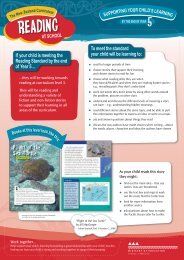Sabbatical Report - Oranga School Website
Sabbatical Report - Oranga School Website
Sabbatical Report - Oranga School Website
Create successful ePaper yourself
Turn your PDF publications into a flip-book with our unique Google optimized e-Paper software.
<strong>Sabbatical</strong> <strong>Report</strong> 2009<br />
added more story elements to, and improved their overall writing quality of<br />
their stories after instruction. It was also found that they spent more time<br />
planning and reviewing during the intervention compared with the baseline<br />
phase. The researchers state that this is “largely consistent with those that<br />
have been observed when strategy instruction is applied to students with<br />
learning disabilities (e.g., Harris and Graham, 1996)” (Albertson & Billingsley,<br />
1997) and important as it indicates that relatively competent writers can also<br />
make substantial gains when provided with direct strategy instruction. The<br />
validity of the Alberton et al. (1997) and De La Paz et al. (2002) studies is<br />
shown through the use of independent observers and interrator agreement<br />
scores of between 81% and 94% for any given criteria.<br />
De La Paz et al. (2002) used a 5 point scale (1 being no planning to 5 being<br />
advanced), which included evaluation of elaboration and accuracy to evaluate<br />
planning. Using ANOVA 6 statistics it was established that eighty percent of<br />
students in the pre-test did no advanced planning, while after the intervention<br />
through post-test and maintenance measures it was established the majority<br />
of students in both the groups pre-planned, but the plans of the experimental<br />
group were better developed. Ninety percent of these students compared with<br />
only 30% and 65% of the control students’ scored 4 or 5 at the post-test and<br />
maintenance. After instruction and 1 month later, students in the experimental<br />
group wrote papers significantly longer than those students in the control<br />
group. Students’ in the experimental group wrote papers with a greater<br />
number of different words that were seven letters or longer compared with the<br />
control students. This was maintained 1 month afterwards. It was shown that<br />
after instruction and one month afterwards the students in the experimental<br />
group were judged to write essays of higher overall quality than the control<br />
group.<br />
The studies have shown that the teaching of strategies to the participants has<br />
been effective. The studies started with the collection of baseline data from<br />
participants and the following instruction interventions included teaching both<br />
planning and reviewing strategies. This included teacher instruction through to<br />
handouts and discussion with the instructor. Formal evaluations indicated that<br />
instruction modified both what and how students’ wrote. Prior to the start of<br />
the interventions, the participating students did not plan in advance of their<br />
writing. Following instruction, however they consistently used the strategies<br />
taught through the intervention (i.e., STOP & LIST, TREE, C-SPACE).<br />
The studies showed that their stories became longer, of higher quality and<br />
more complete. In the Graham et al. (1998) study this even generalised to a<br />
second genre and the effects of the intervention were maintained at the<br />
writing probe administered almost one month after the instruction had<br />
finished. De La Paz et al. (2002) showed also that the effect on instruction<br />
was still positively maintained at one month after instruction had finished.<br />
6 ANOVA: analysis-of-variance<br />
Jonathan Ramsay<br />
<strong>Oranga</strong> Primary - One Tree Hill - Auckland




